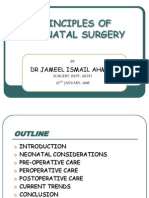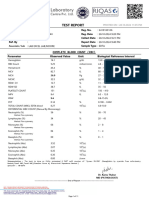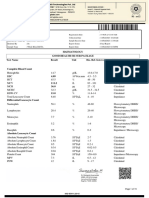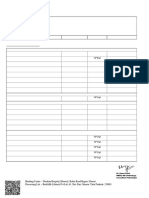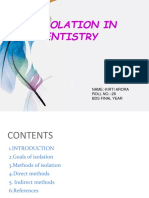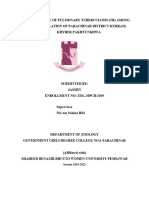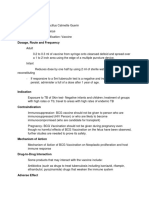RENUKA BISWAS_042411110084
RENUKA BISWAS_042411110084
Uploaded by
arghyasaha7416Copyright:
Available Formats
RENUKA BISWAS_042411110084
RENUKA BISWAS_042411110084
Uploaded by
arghyasaha7416Copyright
Available Formats
Share this document
Did you find this document useful?
Is this content inappropriate?
Copyright:
Available Formats
RENUKA BISWAS_042411110084
RENUKA BISWAS_042411110084
Uploaded by
arghyasaha7416Copyright:
Available Formats
NAME
THEISM DIAGNOSTICS
:Ms. RENUKA BISWAS
AGE/GENDER :62 Y/Female INVOICE DATE :11/Nov/2024 12:02PM
TESTREQUEST ID :042411110084 SPECIMEN COLLECTED :11/Nov/2024 01:45PM
REFERRED BY :Dr. Santosh Kumar REPORT DATE :11/Nov/2024 05:37PM
Test Name Result Bio.Ref.Int. Unit Method
BIOCHEMISTRY
Primary Sample Type:Fluoride Plasma-R
Glucose Random 80 70-140 mg/dL Hexokinase
Primary Sample Type:Serum
Urea 25 21-43 mg/dl GLDH-Urease
Creatinine 0.89 < 1.12 mg/dl Enzymatic
SGPT (ALT) 38 < 28 U/L IFCC
SGOT (AST) 25 ≤ 32 U/L IFCC
Sodium 129 136 - 145 mmol/L ISE(Indirect)
N.B : Please correlate clinically.
Potassium 5.2 3.5 - 5.1 mmol/L ISE(Indirect)
N. B : Please correlate clinically.
Equipment Used:Cobas_6000
Print DateTime: 13-11-2024 20:39:39 Printed By:KAUSIK SAHA Page 1 of
Standard 13
NAME
THEISM DIAGNOSTICS
:Ms. RENUKA BISWAS
AGE/GENDER :62 Y/Female INVOICE DATE :11/Nov/2024 12:02PM
TESTREQUEST ID :042411110084 SPECIMEN COLLECTED :11/Nov/2024 01:45PM
REFERRED BY :Dr. Santosh Kumar REPORT DATE :11/Nov/2024 05:40PM
Test Name Result Bio.Ref.Int. Unit Method
HAEMATOLOGY
CBC/COMPLETE HAEMOGRAM
Primary Sample Type:EDTA Blood
Haemoglobin 10.3 12-15 gm/dl Non Cyanmeth Hb/SLS
Colorimetric
Total count
Erythrocytic 3.95 3.8-4.8 mil/cu.mm DC detection
Leucocytic 7560 4000-10000 /cu.mm Fluorescent flow
cytometry
Differential leucocyte count
Neutrophil 66.0 40-80 % Fluorescent flow
cytometry/Microscopy
Lymphocytes 24.6 20-40 % Fluorescent flow
cytometry/Microscopy
Monocytes 6.3 02-10 % Fluorescent flow
cytometry/Microscopy
Eosinophils 2.8 01-06 % Fluorescent flow
cytometry/Microscopy
Basophils 0.3 0-2 % Fluorescent flow
cytometry/Microscopy
Absolute Leucocyte Count
Neutrophil. 4,990 2000-7000 /cu.m Fluorescent flow
cytometry
Lymphocyte. 1,860 1000-3000 /cu.m Fluorescent flow
cytometry
Monocyte. 480 200-1000 /cu.m Fluorescent flow
cytometry
Eosinophil. 210 20-500 /cu.m Fluorescent flow
cytometry
Basophil. 20 20-100 /cu.m Fluorescent flow
cytometry
Equipment Used:XN1000
Print DateTime: 13-11-2024 20:39:39 Printed By:KAUSIK SAHA Page 2 of
Standard 13
NAME :Ms. RENUKA BISWAS
AGE/GENDER :62 Y/Female INVOICE DATE :11/Nov/2024 12:02PM
TESTREQUEST ID :042411110084 SPECIMEN COLLECTED :11/Nov/2024 01:45PM
REFERRED BY :Dr. Santosh Kumar REPORT DATE :11/Nov/2024 05:40PM
Test Name Result Bio.Ref.Int. Unit Method
Platelet count 1.84 1.5-4.1 lakhs/cu.mm DC
detection/Microscopy
ESR 1st Hour 48 <35 mm/1st hr Modified Westergren
PCV 33.4 36-46 % Cumulative pulse height
detection
MCV 84.6 83-101 fL Calculated
MCH 26.1 27-32 pg Calculated
MCHC 30.8 31.5-34.5 % Calculated
Rdw-cv 15.5 11.4-14.0 % Calculated
Equipment Used:XN1000
Print DateTime: 13-11-2024 20:39:39 Printed By:KAUSIK SAHA Page 3 of
Standard 13
NAME
THEISM DIAGNOSTICS
:Ms. RENUKA BISWAS
AGE/GENDER :62 Y/Female INVOICE DATE :11/Nov/2024 12:02PM
TESTREQUEST ID :042411110084 SPECIMEN COLLECTED :11/Nov/2024 01:45PM
REFERRED BY :Dr. Santosh Kumar REPORT DATE :11/Nov/2024 05:37PM
Test Name Result Bio.Ref.Int. Unit Method
HAEMATOLOGY
BLOOD GROUP RH TYPE
ABO B Forward and Reverse
grouping (Slide & Tube)
Rh typing Positive
NOTE :
* Apart from major A,B,H antigens which are used for ABO grouping and Rh typing, many minor blood group
antigens exist. Agglutination may also vary according to titre of antigen and antibody.
* So before transfusion, reconfirmation of blood group as well as cross-matching is needed.
* Presence of maternal antibodies in newborns, may interfere with blood grouping.
* Auto agglutination (due to cold antibody, falciparum malaria, sepsis, internal malignancy etc.) may also cause
erroneous result.
Print DateTime: 13-11-2024 20:39:39 Printed By:KAUSIK SAHA Page 4 of
Standard 13
NAME
THEISM DIAGNOSTICS
:Ms. RENUKA BISWAS
AGE/GENDER :62 Y/Female INVOICE DATE :11/Nov/2024 12:02PM
TESTREQUEST ID :042411110084 SPECIMEN COLLECTED :11/Nov/2024 01:45PM
REFERRED BY :Dr. Santosh Kumar REPORT DATE :11/Nov/2024 05:50PM
Test Name Result Bio.Ref.Int. Unit Method
HAEMATOLOGY
PROTHROMBIN TIME (P-TIME)
Primary Sample Type:SODIUM CITRATE
Prothrombin Time (P Time) 10.30 11-16 Sec.
MNPT (Control) 10.60 Sec Optical
turbodensitometry
Ratio(Test:Mnpt) 0.97
International normalized ratio (INR) 0.97 (0.8--1.2: for patient not on anticoagulants)
(2.0-3.0:for patients on anticoagulants)
(2.5-3.5: for patients with mechanical heart valve)
Equipment Used: Coagulometer (CA-104)
Print DateTime: 13-11-2024 20:39:39 Printed By:KAUSIK SAHA Page 5 of
Standard 13
NAME
THEISM DIAGNOSTICS
:Ms. RENUKA BISWAS
AGE/GENDER :62 Y/Female INVOICE DATE :11/Nov/2024 12:02PM
TESTREQUEST ID :042411110084 SPECIMEN COLLECTED :11/Nov/2024 01:45PM
REFERRED BY :Dr. Santosh Kumar REPORT DATE :11/Nov/2024 05:13PM
Test Name Result Bio.Ref.Int. Unit Method
HAEMATOLOGY
GLYCOSYLATED HAEMOGLOBIN (HBA1C)
Primary Sample Type:EDTA Blood
Glycosylated Hemoglobin (HbA1c) 5.40 % HPLC
Non diabetic/Excellent control : 4 – 6 %
Good control : 6-7 %
Unsatisfactory control : 7-8 %
Poor control : >8 %
According to ADA (AMERICAN DIABETIC ASSOCIATION): Prediabetes HbA1c : 5.7%-6.4%
Diabetes HbA1c : ≥ 6.5%
Assay done by : Bio-Rad : D-10 (HPLC) / VARIANT II TURBO
ADA criteria for correlation between HbA1c & Mean plasma glucose levels:
(Last three month's average).
HbA1c (%) Mean Plasma Glucose (mg / dl)
6 126
7 154
8 183
9 212
10 240
11 269
12 298
Factors that Interfere with HbA1c Measurement : Genetic variants (e.g. HbS trait), elevated fetal hemoglobin (HbF)
and chemically modified derivatives of hemoglobin (e.g. carbamylated Hb in patients with renal failure) can affect the accuracy
of HbA1c measurements. The effects vary depending on the specific Hb variant or derivative and the specific HbA1c method.
Factors that affect Interpretation of HbA1c Results : Any condition that shortens erythrocyte survival or decreased mean
Print DateTime: 13-11-2024 20:39:39 Printed By:KAUSIK SAHA Page 6 of
Standard 13
NAME :Ms. RENUKA BISWAS
AGE/GENDER :62 Y/Female INVOICE DATE :11/Nov/2024 12:02PM
TESTREQUEST ID :042411110084 SPECIMEN COLLECTED :11/Nov/2024 01:45PM
REFERRED BY :Dr. Santosh Kumar REPORT DATE :11/Nov/2024 05:13PM
Test Name Result Bio.Ref.Int. Unit Method
erythrocyte are (e.g. recovery from acute blood loss, hemolytic anemia) will falsely lower HbA1c test results regardless of the
asaay method used.
1. Erythropoiesis :: Increased hbA1c : Iron, Vitamin B12 deficiency, decreased erythropoietin.
Decreased HbA1c : Administration of erythropoietin, iron, vitamin B12, reticulocytosis, chronic Liver disease.
2. Altered Haemoglobin :: Genetic or chemical alterations in haemoglobin : Haemoglobinopathies, HbF,
methaemoglobin, may increase or decrease HbA1c.
3. Glycation :: Increased HbA1c : Alcoholism, chronic renal failure, decreased intraerythrocyte pH.
Decreased HbA1c : Aspirin, vitamin C and E, certain Haemoglobinopathies, increased intraerythrocyte pH.
Variable HbA1c : Genetic determinants.
4. Erythrocyte destruction :: Increased HbA1c : Increased erythrocyte life span : Splenectomy.
Decreased A1c : Decreased erythrocyte life span : haemoglobinopathies, splenomegaly, rheumatoid arthritis or
drugs such as antiretrovirals, ribavirin and dapsone.
5. Assays :: Increased HbA1c : Hyperbilirubinaemia, carbamylated haemoglobin, alcoholism, large dose of Aspirin,
chronic opiate use.
Variable HbA1c : Haemoglobinopathies.
Decreased HbA1c : Hypertriglyceridaemia.
6. Falsely Low HbA1c : Dapsone, Ribavirin, Antiretrovirals, Trimethoprim-Sulfamethoxazole, Hydroxyurea, Vitamin C,
Vitamin E, Aspirin (small doses).
Falsely High HbA1c : Aspirin (large doses) Chronic opiate use.
Print DateTime: 13-11-2024 20:39:39 Printed By:KAUSIK SAHA Page 7 of
Standard 13
NAME
THEISM DIAGNOSTICS
:Ms. RENUKA BISWAS
AGE/GENDER :62 Y/Female INVOICE DATE :11/Nov/2024 12:02PM
TESTREQUEST ID :042411110084 SPECIMEN COLLECTED :12/Nov/2024 03:09PM
REFERRED BY :Dr. Santosh Kumar REPORT DATE :12/Nov/2024 06:15PM
Test Name Result Bio.Ref.Int. Unit Method
CLINICAL PATHOLOGY
URINE RE
Primary Sample Type:Urine
Physical examination
Quantity 40 mL
Colour Watery
Appearance Clear Clear
Deposits Nil
Sp.gravity 1.005 1.003-1.030 Ions concentration
Chemical examination
Reaction Acidic Double indicator pH
range
Urine protein Nil Nil Protein Error Indicator
Urine Sugar Nil Nil GOD POD Reaction
Ketones Nil Nil Nitroprusside
Bile salt. Negative Negative Hays Sulphur Test
Bile pigment. Negative Negative Diazo Reaction
Urobilinogen Normal upto 1.0 mg/dl mg/dl Ehrlich Reaction
Phosphates. Nil Nil Heat and Acetic Acid
Blood Nil Nil Peroxidase
Nitrite Negative NEGATIVE P-Arsalinic Acid
Leucocyte Nil Esterase
Microscopical Examination of Centrifuged Deposit
RBC. Nil - /HPF Microscopy
Epithelial cells 2-3 (squamous) Occasional /HPF Microscopy
Pus cells. 1-2 0-4 /HPF Microscopy
Casts Nil Occasional /LPF Microscopy
Crystals Nil - /LPF Microscopy
Micro Organism Nil Microscopy
Yeast cells Nil - Microscopy
Print DateTime: 13-11-2024 20:39:39 Printed By:KAUSIK SAHA Page 8 of
Standard 13
NAME
THEISM DIAGNOSTICS
:Ms. RENUKA BISWAS
AGE/GENDER :62 Y/Female INVOICE DATE :11/Nov/2024 12:02PM
TESTREQUEST ID :042411110084 SPECIMEN COLLECTED :11/Nov/2024 01:45PM
REFERRED BY :Dr. Santosh Kumar REPORT DATE :11/Nov/2024 06:00PM
Test Name Result Bio.Ref.Int. Unit Method
ENDOCRINOLOGY
T4 + TSH
Primary Sample Type:Serum
Serum T4 7.10 5.10-14.1 µg/dl ECLIA
TSH 0.903 0.27-4.20 µIU/ml ECLIA
(Pregnancy :
1st Trimester:0.1-2.5
2nd Trimester:0.2-3.0
3rd Trimester:0.3-3.0)
NOTE:
1. Biotin containing medications can interfare with results. There should be a gap of atleast eight hours between
biotin intake and giving blood sample.
2.TSH levels are subject to circadian variation, reaching peak levels between 2-4 am and at a minimum
between 6-10 pm.
The variation is of the order of 50%, hence time of the day has influence on the measured serum TSH
concentrations.
3.Subclinical hypothyroidism is diagnosed when you have:
• No symptoms or mild symptoms of hypothyroidism. ( Like fatigue, cold intolerance, consistent weight
gain, depression or memory problems).
• A mildly high thyroid-stimulating hormone (TSH) level.
• A normal thyroxine (T4) level.
• A TSH level < 10 µIU/mL may be followed up by re-estimation after 4-8 weeks before starting treatment.
• Viral infection, common cold etc. May cause transient increase in TSH for few days, which will revert to
normal after the illness passes away.
4. Values < 0.03 µlU/mL need to be clinically correlated due to presence of a rare TSH variant in some individuals.
Equipment Used:Cobas_6000
Print DateTime: 13-11-2024 20:39:39 Printed By:KAUSIK SAHA Page 9 of
Standard 13
NAME
THEISM DIAGNOSTICS
:Ms. RENUKA BISWAS
AGE/GENDER :62 Y/Female INVOICE DATE :11/Nov/2024 12:02PM
TESTREQUEST ID :042411110084 SPECIMEN COLLECTED :11/Nov/2024 01:45PM
REFERRED BY :Dr. Santosh Kumar REPORT DATE :11/Nov/2024 06:24PM
Test Name Result Bio.Ref.Int. Unit Method
SEROLOGY
HIV I & II
HIV - I & II 0.09 CMIA
Kit Used : ARCHITECT HIV Ag/Ab Combo Reagent Kit.
Interpretation of Results :
. Specimens with S/CO values < 1.00 are considered Non-Reactive (NR).
. Specimens with S/CO values ≥ 1.00 are considered Reactive (R)
Limitations Of The Procedure :
1. This is only a screening test confirmatory testing by other methods is necessary for diagnosis.
2. Definitive clinical diagnosis should not be made based only on the result of single test. A complete evaluation
by physician is needed for a final diagnosis.
3. Specimens from patients who have received preparations of mouse monocional antibodies for diagnosis or
therapy may contain human anti-mouse antibodies (HAMA). Such specimens may show either falsely
elevated or depressed values when tested with assay kits that employ mouse monocional antibodies.
ARCHITECT HIV Ag/Ab Combo reagents contain a component that reduces the effect of HAMA reactive
specimens. Additional clinical or diagnostic information may be required to determine patient status.
4. Heterophilic antibodies in human serum can react with reagent immunoglobulins, interfering with in vitro
immunoassays. Patients routinely exposed to animals or to animal serum products can be prone to this
interference and anomalous values may be observed. Additional information may be required for diagnosis.
Equipment Used:Architect_ci4100
Print DateTime: 13-11-2024 20:39:39 Printed By:KAUSIK SAHA Page 10
Standard of 13
NAME
THEISM DIAGNOSTICS
:Ms. RENUKA BISWAS
AGE/GENDER :62 Y/Female INVOICE DATE :11/Nov/2024 12:02PM
TESTREQUEST ID :042411110084 SPECIMEN COLLECTED :11/Nov/2024 01:45PM
REFERRED BY :Dr. Santosh Kumar REPORT DATE :11/Nov/2024 05:12PM
Test Name Result Bio.Ref.Int. Unit Method
SEROLOGY
HCV CARD TEST
Anti-HCV ANTIBODY DETECTION Non-Reactive Immunochromatography
Note : i. The HCV Tri-Dot HCV test detects anti-HCV in human serum or plasma and is only a screening
test. All reactive samples should be confirmed by supplemental assays like RIBA, PCR. Therefore for a definitive
diagnosis, the patient's clinical history, symptomatology as well as serological data, should be considered.
ii. A non-reactive result does not exclude the possibility of exposure to or infection with HCV.
iii. The presence of anti-HCV does not imply a Hepatitis C infection but may be indicative of recent and /or
past infection by HCV.
iv. Patients with auto-immune liver disease may show falsely reactive results
Print DateTime: 13-11-2024 20:39:39 Printed By:KAUSIK SAHA Page 11
Standard of 13
NAME
THEISM DIAGNOSTICS
:Ms. RENUKA BISWAS
AGE/GENDER :62 Y/Female INVOICE DATE :11/Nov/2024 12:02PM
TESTREQUEST ID :042411110084 SPECIMEN COLLECTED :11/Nov/2024 01:45PM
REFERRED BY :Dr. Santosh Kumar REPORT DATE :11/Nov/2024 06:24PM
Test Name Result Bio.Ref.Int. Unit Method
SEROLOGY
HbsAg 0.27 S/CO ≥ 1.0 = Reactive S/CO
S/CO < 1.0 = Non-reactive
Method : CMIA
Note:
HBsAg usually appears 4 weeks after viral exposure but can be detected any time after the first week. An individual positive for
HBsAg is considered to be infected and is therefore potentially infectious. Persistence of HBsAg is used to differentiate acute from
chronic infection. Presence of the antigen longer than 6 months after initial exposure indicates chronic infection. However, the level
of the antigen does not appear to correlate with disease severity. HBsAg can be cleared by normal immune response, and only
1% of patients with acute HBV exposure are estimated to progress to a chronic state. Detection of anti-HBs in the serum implies
either active or passive immunization that usually persists for life.
Anti-HBc is the first detectable antibody in the course of HBV disease. IgM anti-HBc indicates acute infection and is the only
serologic marker detectable during the “Window period,” when neither HBsAg nor anti-HBc is detectable. Once IgG anti HBc
appears in the serum, it persists for life. Detection of IgG anti-HBc indicates previous or ongoing infection.
Individuals with positive HbeAg results have been shown to have higher rates or viral transmission; therefore, the antigen is used as
a marker of viral replication and infectivity. However, HbeAg testing is indicated primarily during follow-up of chronic infection
rather than acute infection because of its variable level during the acute phase.
Equipment Used:Architect_ci4100
Print DateTime: 13-11-2024 20:39:39 Printed By:KAUSIK SAHA Page 12
Standard of 13
THEISM DIAGNOSTICS
NAME :Ms. RENUKA BISWAS
AGE/GENDER :62 Y/Female INVOICE DATE :11/Nov/2024 12:02PM
TESTREQUEST ID :042411110084 SPECIMEN COLLECTED :11/Nov/2024 01:45PM
REFERRED BY :Dr. Santosh Kumar REPORT DATE :13/Nov/2024 02:21PM
MICROBIOLOGY
CULTURE AND SENSITIVITY (AEROBIC)
Primary Sample Type : Urine
Routine Culture : Aerobic: No significant microorganism grown after 48 hours
of aerobic incubation at 37ºC.
*** End Of Report ***
Print DateTime: 13-11-2024 20:39:39 Printed By:KAUSIK SAHA Page 13
Standard of 13
THEISM ULTRASOUND CENTRE PATIENT REPORT
BIO-RAD VARIANTII TURBO S/N: 16549 V2TURBO_A1c_2.0
Patient Data Analysis Data
Sample ID: 21199001 Analysis Performed: 11/11/2024 16:03:05
Patient ID: 084 Injection Number: 3496U
Name: Run Number: 138
Physician: Rack ID: 0003
Sex: Tube Number: 3
DOB: Report Generated: 11/11/2024 16:08:44
Operator ID:
Comments:
NGSP Retention Peak
Peak Name % Area % Time (min) Area
A1a --- 1.1 0.162 26190
A1b --- 0.9 0.233 22457
F --- 0.6 0.280 14660
LA1c --- 1.5 0.416 35720
A1c 5.4 --- 0.527 109237
P3 --- 3.6 0.813 86336
P4 --- 1.2 0.881 29931
Ao --- 86.5 1.002 2084895
Total Area: 2,409,426
HbA1c (NGSP) = 5.4 %
20.0
17.5
15.0
12.5
%A1c
10.0
0.53
0.81
7.5
A1c -
0.88
-
0.23
0.42
5.0
0.16
0.28
-
-
2.5
1.00
-
0.0
-
0.00 0.25 0.50 0.75 1.00 1.25 1.50
Time (min.)
You might also like
- Lab Report 13163706 20230601014500Document5 pagesLab Report 13163706 20230601014500Saifu M AsathNo ratings yet
- Preop ChecklistDocument2 pagesPreop ChecklistJan Federick Bantay83% (6)
- 1-Complete Blood Count - PO1106326185-399Document8 pages1-Complete Blood Count - PO1106326185-399Arup KumarNo ratings yet
- Co AmoxiclavDocument1 pageCo AmoxiclavClarissa GuifayaNo ratings yet
- Principles of Neonatal SurgeryDocument44 pagesPrinciples of Neonatal Surgerykbmed2003100% (2)
- LabReportNewDocument3 pagesLabReportNewkushwahasalu17No ratings yet
- Wa0000.Document14 pagesWa0000.GauravNo ratings yet
- ITD148515 CPL DiagnosticDocument8 pagesITD148515 CPL Diagnosticsribhrama1996No ratings yet
- PN160759Document9 pagesPN160759telcoworld24No ratings yet
- Report 64a4a70dDocument7 pagesReport 64a4a70dSneh AnkurNo ratings yet
- Report 8834f54dDocument3 pagesReport 8834f54dSneh AnkurNo ratings yet
- Archana Lab ReportDocument10 pagesArchana Lab Reportprabalsoni125No ratings yet
- Test ReportsDocument4 pagesTest ReportsGreen EWasteNo ratings yet
- Report A6ce2fa7Document4 pagesReport A6ce2fa7mangalamperfumeryNo ratings yet
- District Women Hospital: Nqas Certified Pathology Lab Muzaffarnagar, Uttar Pradesh MuzaffarnagarDocument2 pagesDistrict Women Hospital: Nqas Certified Pathology Lab Muzaffarnagar, Uttar Pradesh MuzaffarnagarmznpoctNo ratings yet
- Lab Report 15592615 20231208104711Document3 pagesLab Report 15592615 20231208104711gemdos07No ratings yet
- report-bd9acc3aa59fb00e77e430d0b98042209ba76fc6Document8 pagesreport-bd9acc3aa59fb00e77e430d0b98042209ba76fc6Himanhu ChaubeNo ratings yet
- Labreportnew - 2024-05-23T110646.965Document4 pagesLabreportnew - 2024-05-23T110646.965citycarepathNo ratings yet
- Apollo247 251151321 Labreport 120 1727257688975Document2 pagesApollo247 251151321 Labreport 120 1727257688975insurancecouncilofnewzealandNo ratings yet
- lab_report_19895459_20241001045731Document2 pageslab_report_19895459_20241001045731qrs0890No ratings yet
- Report Blood WorkDocument3 pagesReport Blood WorkthegreatnitinkumarNo ratings yet
- PHLB1400496733 PDFDocument15 pagesPHLB1400496733 PDFurmobilehacked123No ratings yet
- DgReportingVF (2)Document2 pagesDgReportingVF (2)kiriti komaragiriNo ratings yet
- Report F4fef8c3Document4 pagesReport F4fef8c3Pragya RathoreNo ratings yet
- Pt. Subhendra JadhavDocument11 pagesPt. Subhendra JadhavmemmdyusufNo ratings yet
- Lab Report NewDocument3 pagesLab Report NewSriram vurrankiNo ratings yet
- Report 28340c20Document10 pagesReport 28340c20Rahul ChaudhariNo ratings yet
- 1-Good Health Silver Package_PO2206291649-655Document15 pages1-Good Health Silver Package_PO2206291649-655xinovi2469No ratings yet
- Labreportnew - 2024-10-04T185037.951Document5 pagesLabreportnew - 2024-10-04T185037.951girlwithukulele1No ratings yet
- report-c7e1aecd1e5a6544d9d6891d3fef23c073259a73Document26 pagesreport-c7e1aecd1e5a6544d9d6891d3fef23c073259a73Devika AgarwalNo ratings yet
- LabTest 28aug2024Document8 pagesLabTest 28aug2024Krishna RaoNo ratings yet
- Tata medical reportDocument6 pagesTata medical reporty4hwpbxsgwNo ratings yet
- ReportDocument12 pagesReportmehershivamvermaNo ratings yet
- HeaderDocument14 pagesHeadermehershivamvermaNo ratings yet
- Po4009507960 540Document15 pagesPo4009507960 540PRADEEP KUMARNo ratings yet
- CBC Dad Sep 16 2024Document4 pagesCBC Dad Sep 16 2024braj.mohanNo ratings yet
- HeaderDocument6 pagesHeaderChintesh MehtaNo ratings yet
- MASTER HRIDAYESH - Investigation ReportsDocument5 pagesMASTER HRIDAYESH - Investigation ReportsRakesh KhetrapalNo ratings yet
- 1-Glucose - Postprandial - PO2611259108-802Document16 pages1-Glucose - Postprandial - PO2611259108-802Meet PatelNo ratings yet
- Ot ReportDocument3 pagesOt ReportmznpoctNo ratings yet
- Blood ReportDocument14 pagesBlood ReportHarsh KatariaNo ratings yet
- AyushDocument7 pagesAyushayushdante1No ratings yet
- 022412090080_Document3 pages022412090080_varshasen345No ratings yet
- Asma 34Document7 pagesAsma 34molecularpathlab.raviNo ratings yet
- Asma 34Document5 pagesAsma 34molecularpathlab.raviNo ratings yet
- PDF TextDocument4 pagesPDF Textayetio999No ratings yet
- CholeDocument12 pagesCholeaquacrystal538No ratings yet
- S Chidambaram: Haematology Good Health Package Test Name Result Unit Bio Ref - Interval MethodDocument11 pagesS Chidambaram: Haematology Good Health Package Test Name Result Unit Bio Ref - Interval MethodRamkumar SundaramNo ratings yet
- Department of Laboratory Sciences: Clinical Biochemistry/ Immuno AsssayDocument3 pagesDepartment of Laboratory Sciences: Clinical Biochemistry/ Immuno AsssayKavyaleen KaurNo ratings yet
- labreportnew (38)Document3 pageslabreportnew (38)shivansh9tamtaNo ratings yet
- Report d4dd50b9Document5 pagesReport d4dd50b9umang.nitk.backupNo ratings yet
- Health Report 2023Document30 pagesHealth Report 2023Pranay GuptaNo ratings yet
- Report 06fbb0d2Document6 pagesReport 06fbb0d2vorahardikaNo ratings yet
- Labreportnew 75Document8 pagesLabreportnew 75Xeia ud din KhanNo ratings yet
- Report 23038ce9Document11 pagesReport 23038ce9taashu187No ratings yet
- Report F8a58b30Document15 pagesReport F8a58b30Neelam KhandekarNo ratings yet
- Report Eb278ee1Document5 pagesReport Eb278ee1sairamsai9905No ratings yet
- ARTH jYJjMn UCiVjQDocument3 pagesARTH jYJjMn UCiVjQraghuveer.ameta92No ratings yet
- FileDocument9 pagesFiley4hwpbxsgwNo ratings yet
- LabReportNew (11)Document18 pagesLabReportNew (11)neeta.nNo ratings yet
- Report D43c21acDocument17 pagesReport D43c21acRAVINo ratings yet
- Haematology Tw-Eygds HC Test Name Result Unit Bio. Ref. Interval MethodDocument15 pagesHaematology Tw-Eygds HC Test Name Result Unit Bio. Ref. Interval MethodGopal SahuNo ratings yet
- Hematologic Manifestation in SLEDocument9 pagesHematologic Manifestation in SLECocieru-SalaruVirginiaNo ratings yet
- Miniature Laparoscopy: For Animals Less Than 10 KGDocument8 pagesMiniature Laparoscopy: For Animals Less Than 10 KGزكريا دبوانNo ratings yet
- Surgical Glove Perforation Among Nurses in Ophthalmic SurgeryDocument8 pagesSurgical Glove Perforation Among Nurses in Ophthalmic SurgeryAdel AdielaNo ratings yet
- Periop PhinmaaugustDocument221 pagesPeriop PhinmaaugustEna RodasNo ratings yet
- Bipolar Disorder Case StudyDocument15 pagesBipolar Disorder Case Studyapi-498427226100% (1)
- Evaluation The Effect of Low Dose Aspirin On Endothelial Dysfunction in Preeclamptic PatientsDocument5 pagesEvaluation The Effect of Low Dose Aspirin On Endothelial Dysfunction in Preeclamptic PatientsAbrahamisnanNo ratings yet
- ISOLATION FinlaiDocument60 pagesISOLATION Finlaikirti arora100% (2)
- The Treatment of Schizoid Personality Disorder Using Psychodynamic MethodsDocument25 pagesThe Treatment of Schizoid Personality Disorder Using Psychodynamic MethodsnikhilNo ratings yet
- Prevelance of Pulmonary Tuberculosis in ParachinarDocument29 pagesPrevelance of Pulmonary Tuberculosis in Parachinarmjsjaved786No ratings yet
- Drug Study 12Document4 pagesDrug Study 12Nathalie kate petallarNo ratings yet
- Peptic Ulcer Therapy - Antiemetics - Laxatives - Antidiarrheal DrugsDocument18 pagesPeptic Ulcer Therapy - Antiemetics - Laxatives - Antidiarrheal Drugsmanik_ghadlingeNo ratings yet
- Damage Control ResuscitationDocument32 pagesDamage Control Resuscitationrima oktariniNo ratings yet
- A Healthy Diet British English Teacher Ver2 BWDocument4 pagesA Healthy Diet British English Teacher Ver2 BWDaniel BourneNo ratings yet
- LipidsDocument60 pagesLipidsMargarette Ann MontinolaNo ratings yet
- Autism and SeizuresDocument37 pagesAutism and SeizuresexbisNo ratings yet
- Master DiagnosisDocument708 pagesMaster DiagnosisardinardinNo ratings yet
- Kel 2 Artikel 5w1h-1Document16 pagesKel 2 Artikel 5w1h-1Anonymous RxjOeoYn9No ratings yet
- Advancement in Partograph WHO's Labor Care GuideDocument7 pagesAdvancement in Partograph WHO's Labor Care GuideSujan ThapaNo ratings yet
- Teaching Plan PDFDocument92 pagesTeaching Plan PDFRoxanne Jane S. Graycochea100% (1)
- Classification of FracturesDocument13 pagesClassification of FracturesRadhika VermaNo ratings yet
- PhenylketonuriaDocument1 pagePhenylketonuriaHolly SevillanoNo ratings yet
- Instructions For Treatment and Use of Insecticide-Treated Mosquito NetsDocument51 pagesInstructions For Treatment and Use of Insecticide-Treated Mosquito NetsMaxwell WrightNo ratings yet
- Luminal ProtozoaDocument68 pagesLuminal ProtozoaHeni Tri RahmawatiNo ratings yet
- The Five-Step Rhinoplasty Dead Space Closure TechniqueDocument2 pagesThe Five-Step Rhinoplasty Dead Space Closure TechniqueAdRiaNa JuLIetH LoZaDa PaTiÑoNo ratings yet
- FBNC Training Module - CPAPDocument4 pagesFBNC Training Module - CPAPeraneonat24No ratings yet
- Biology Bacteria Worksheet ANSWERSDocument2 pagesBiology Bacteria Worksheet ANSWERSPsudopodNo ratings yet
- Nursing Management of Oral Hygiene: Moh Nursing Clinical Practice Guidelines 1/2004Document40 pagesNursing Management of Oral Hygiene: Moh Nursing Clinical Practice Guidelines 1/2004Riris RaudyaNo ratings yet




